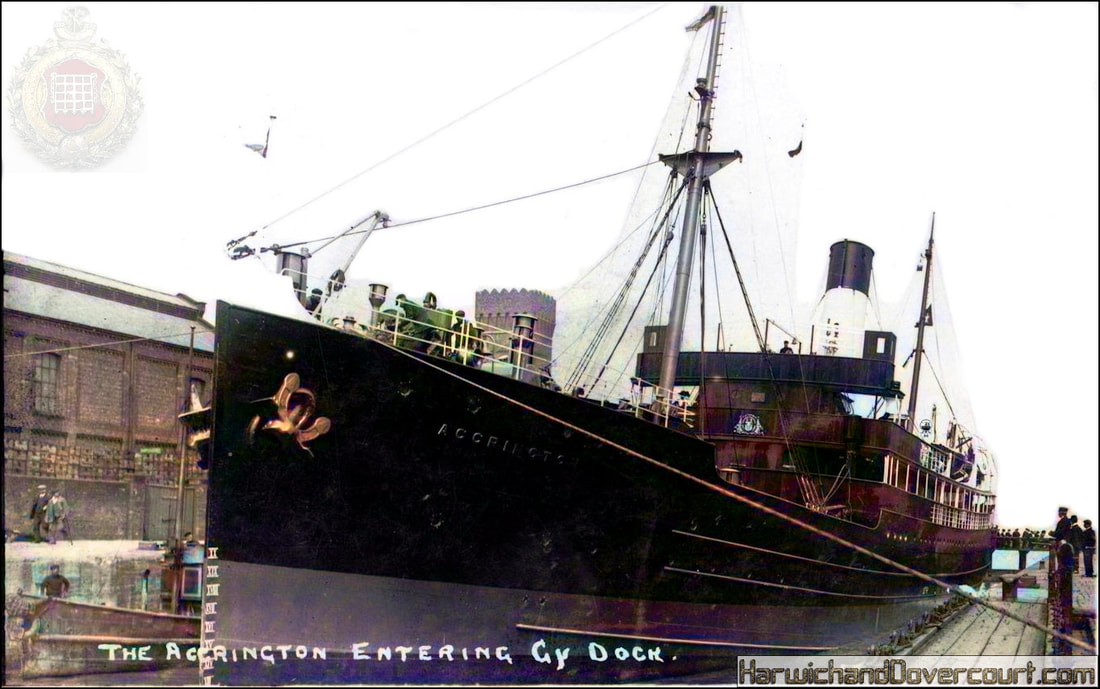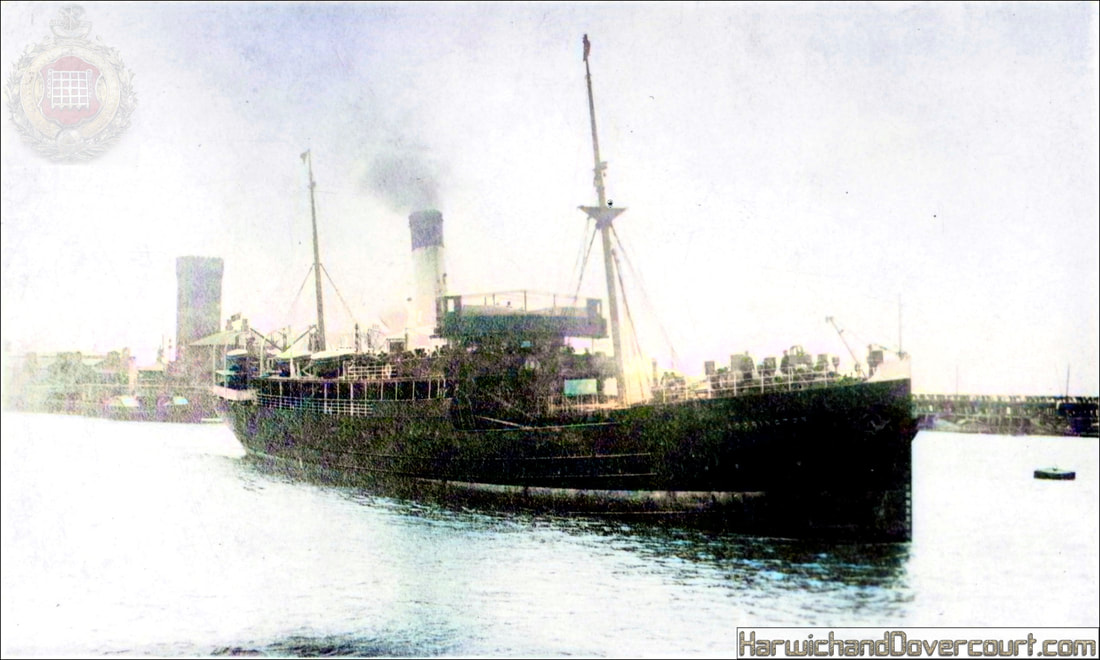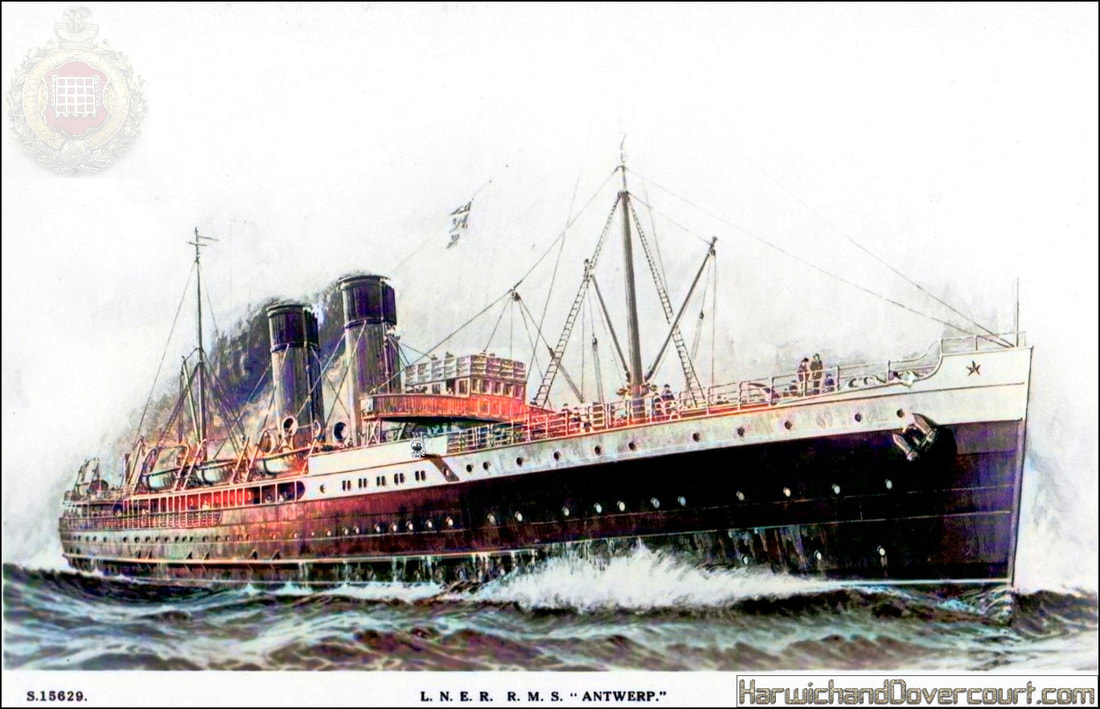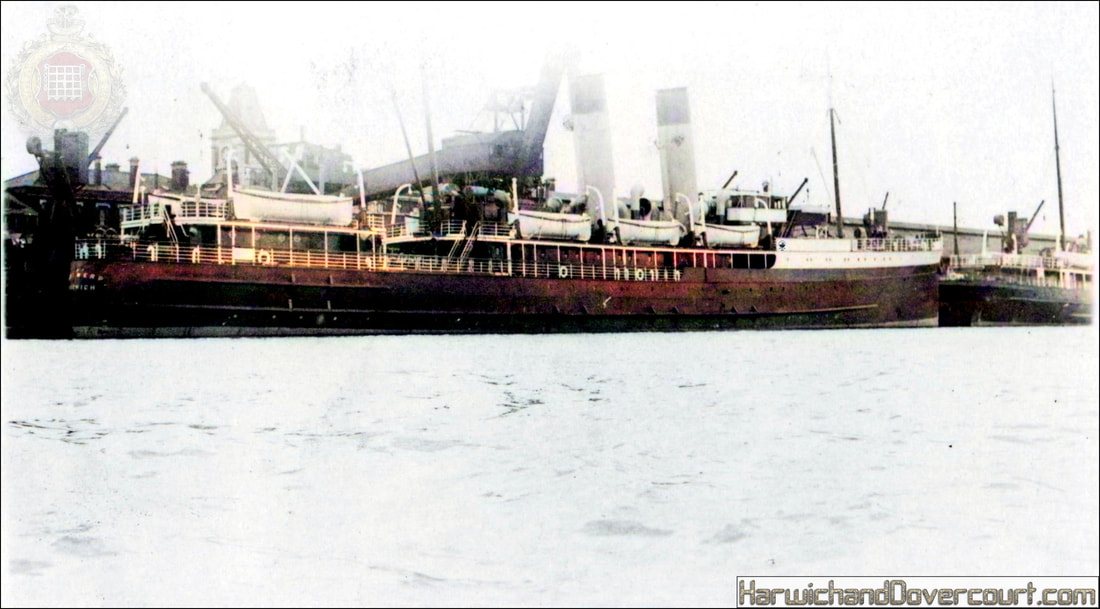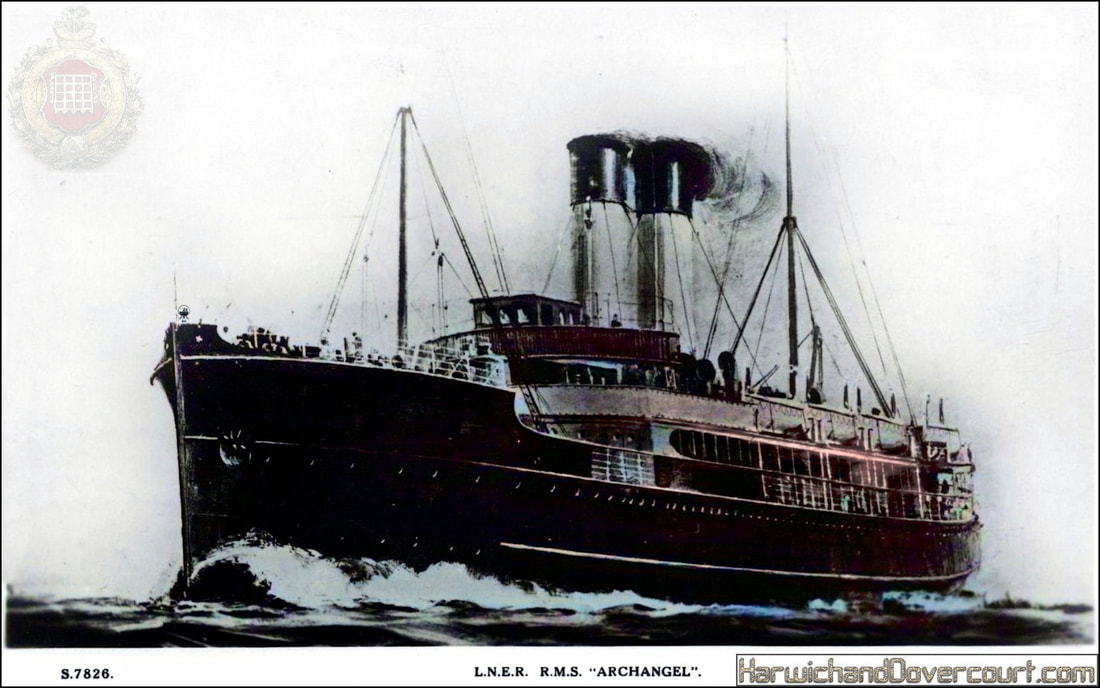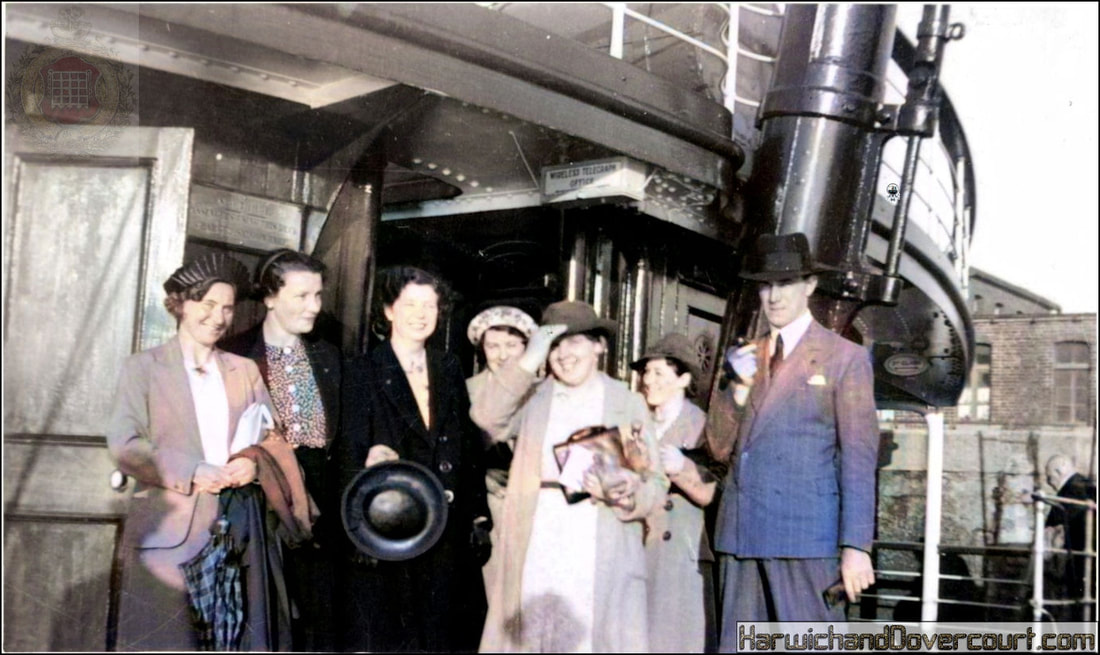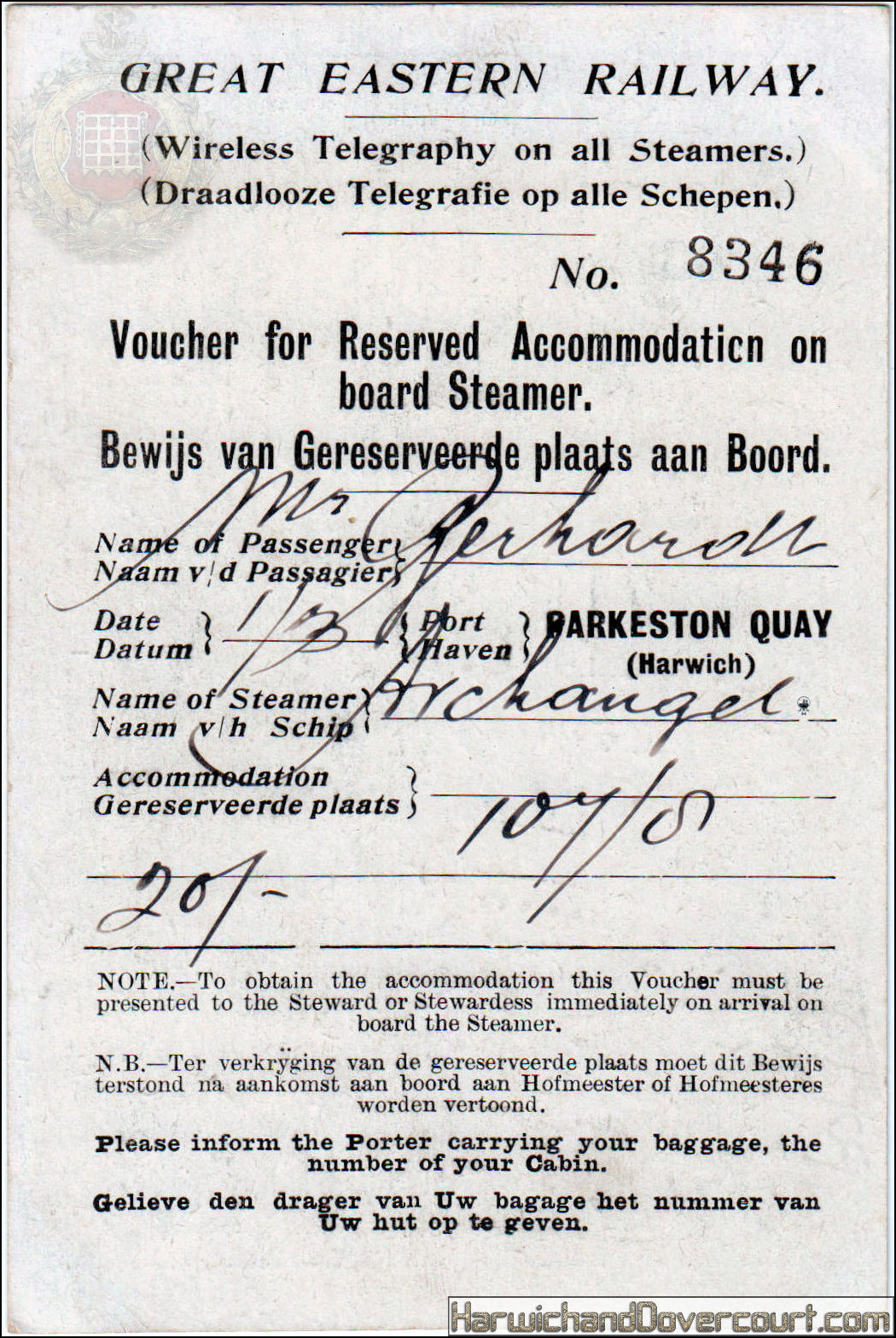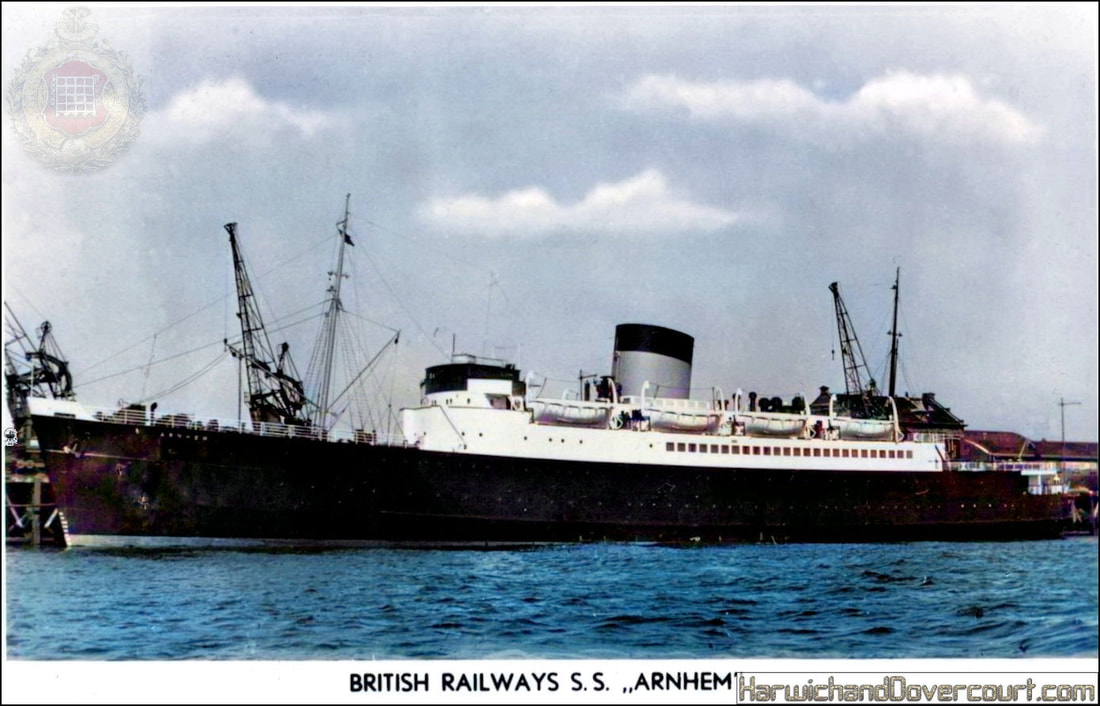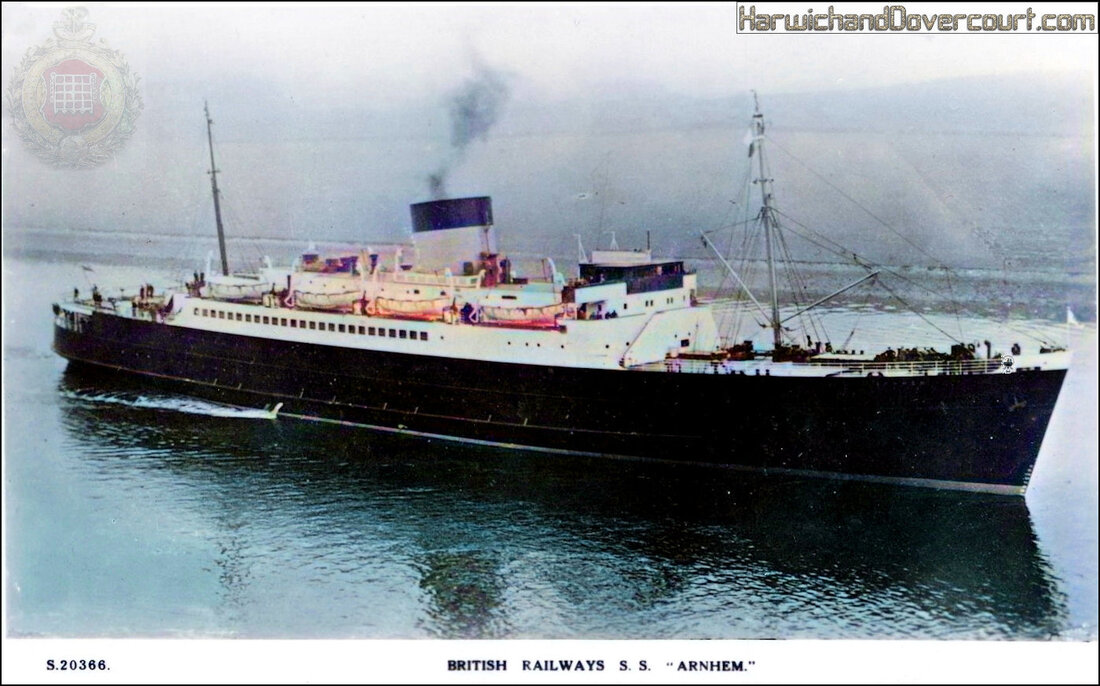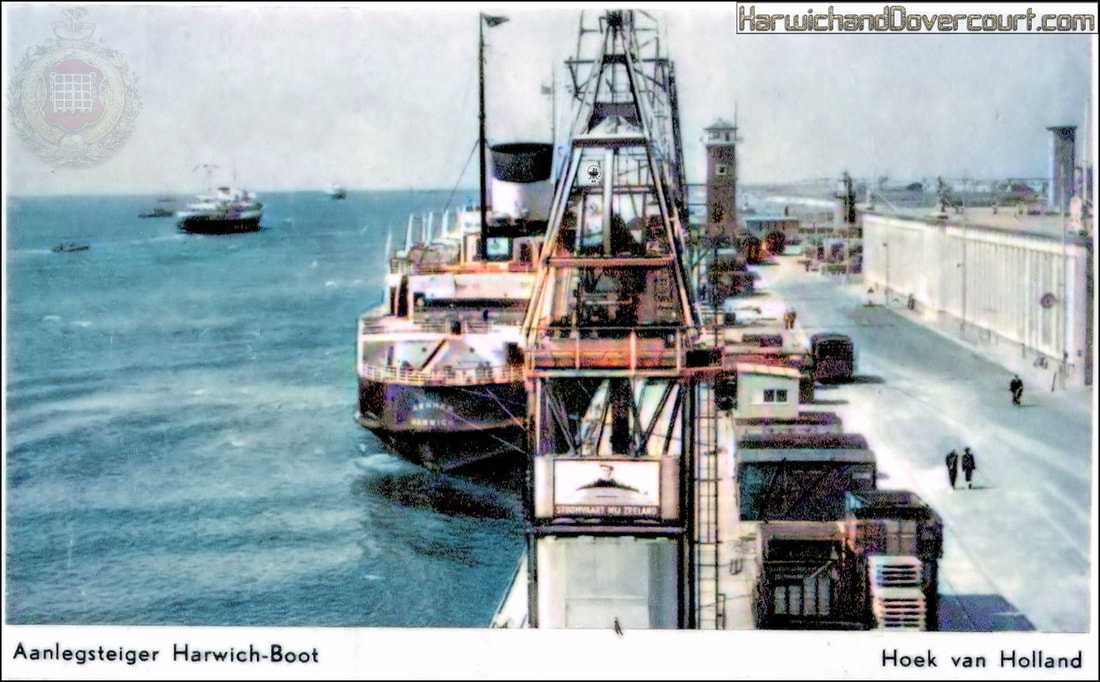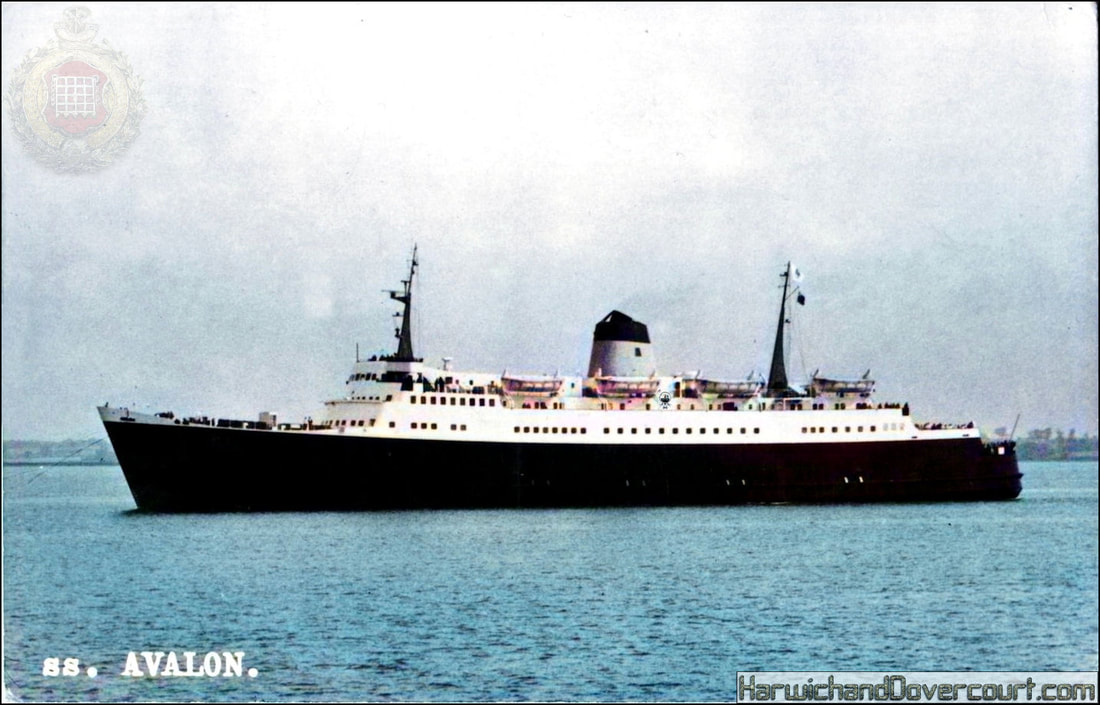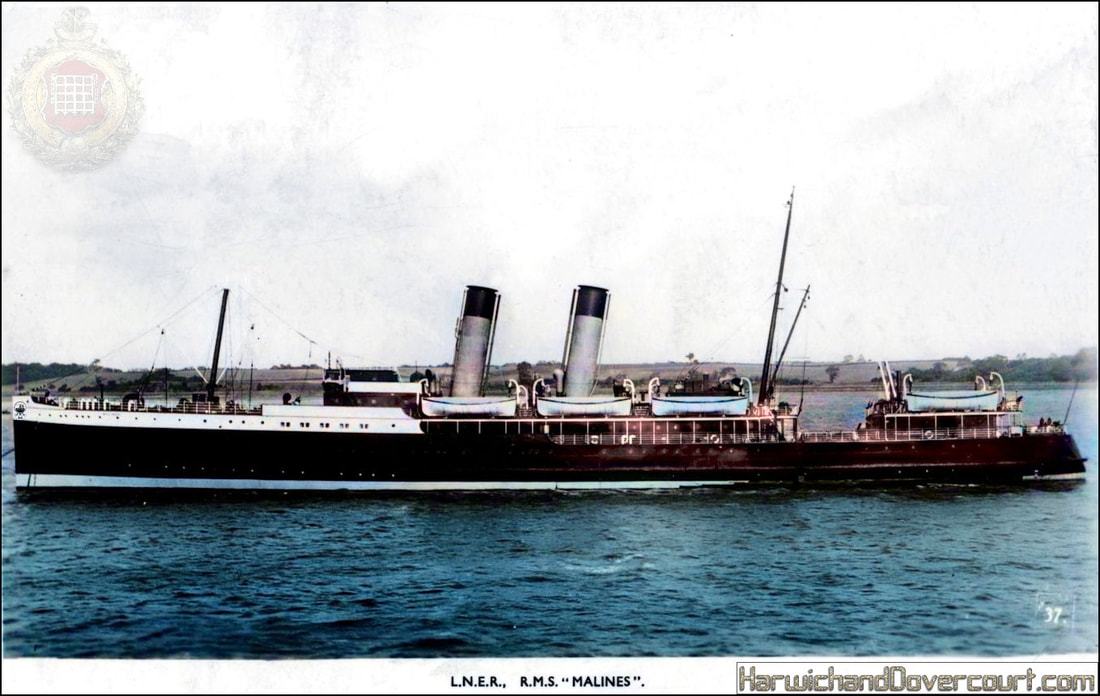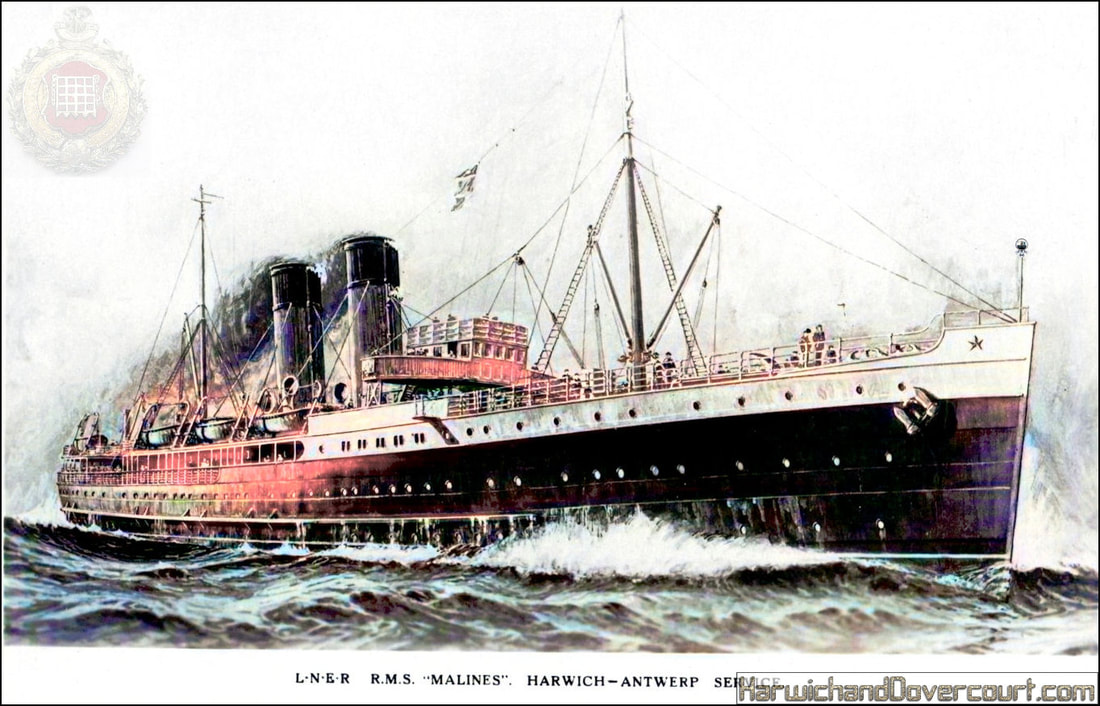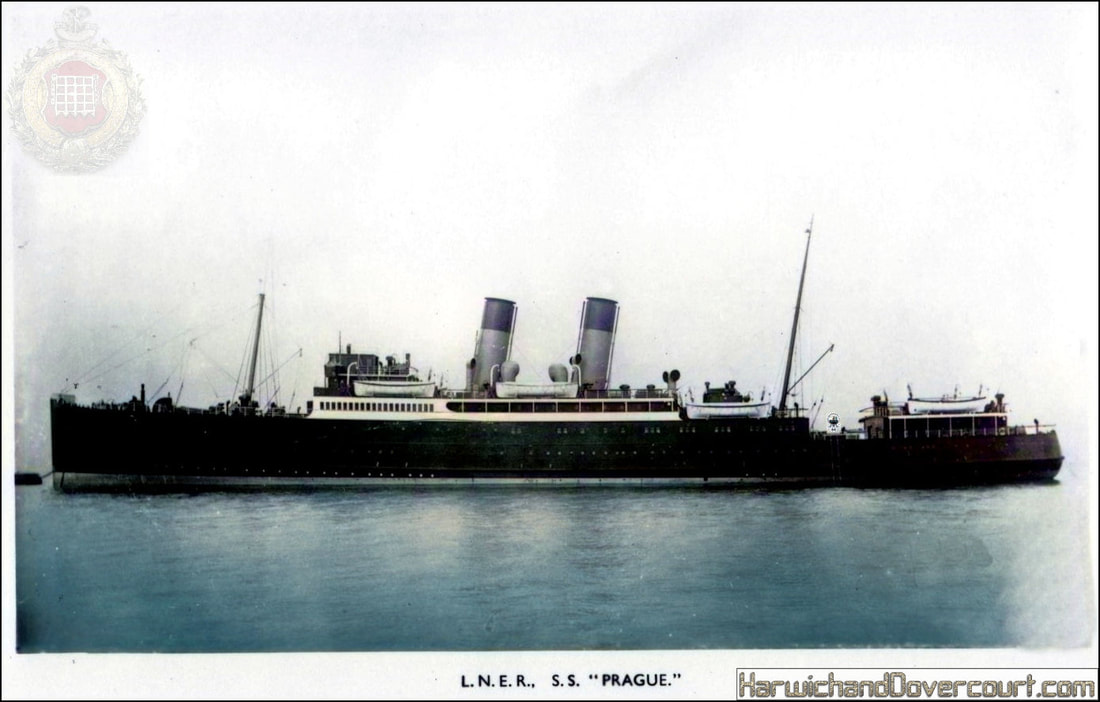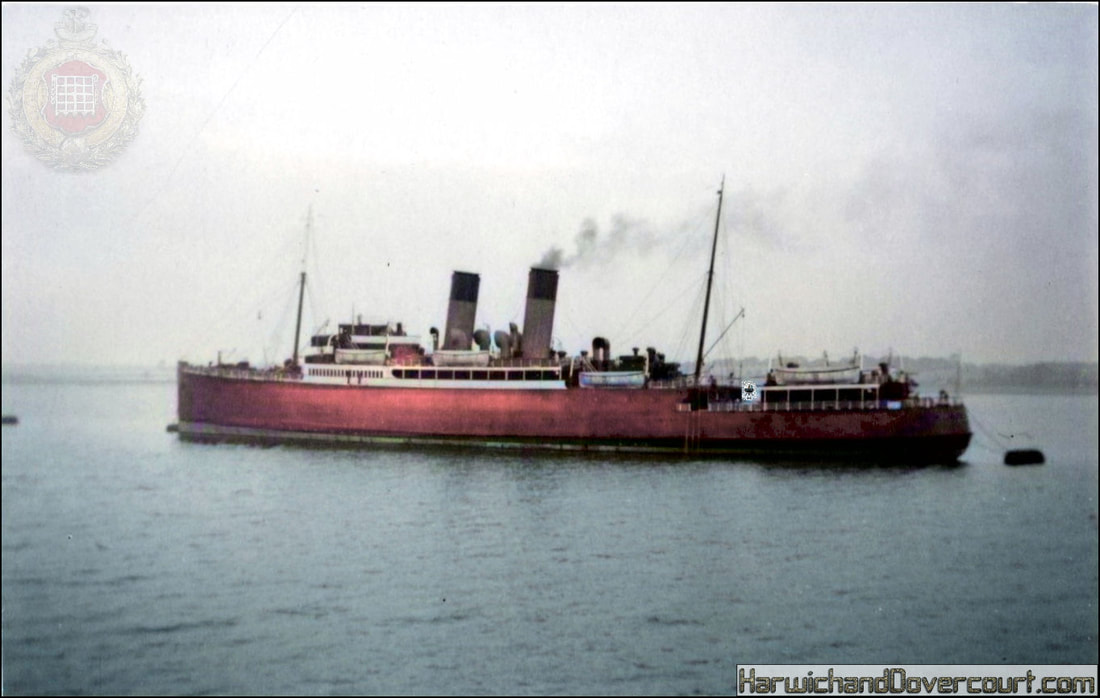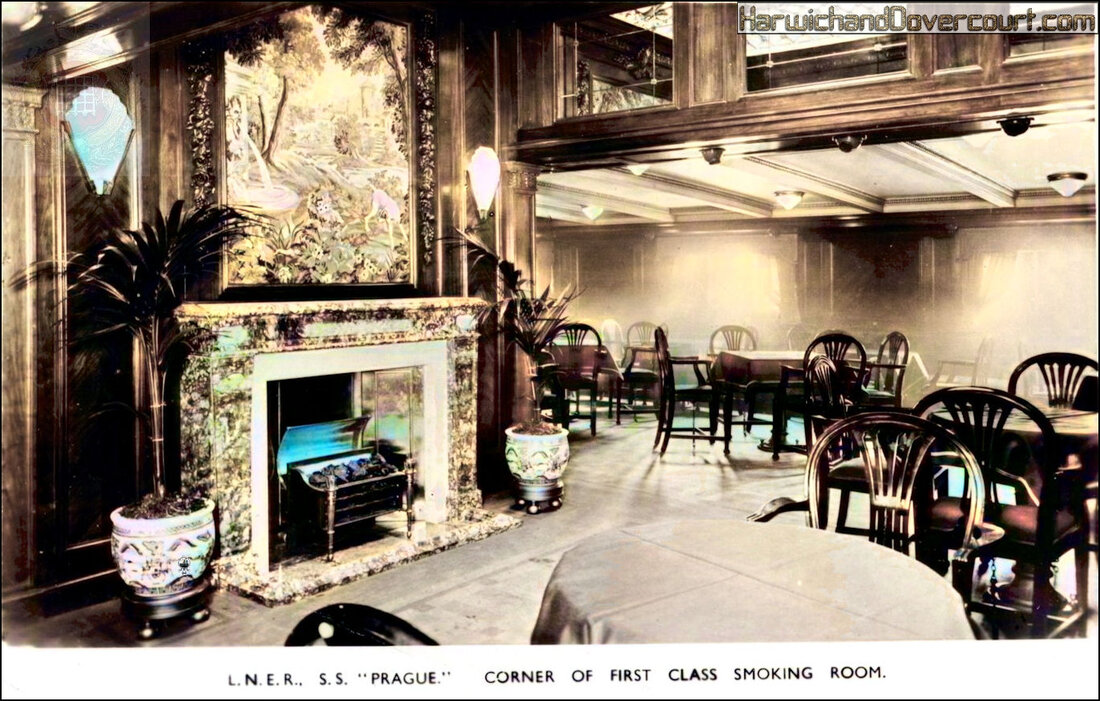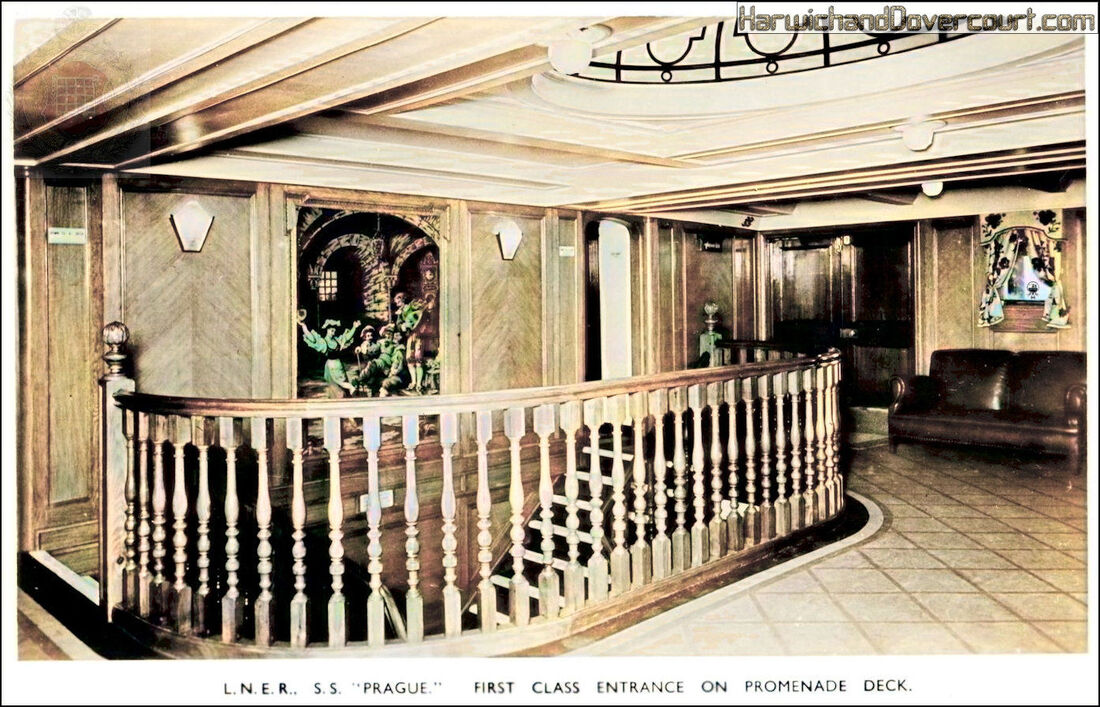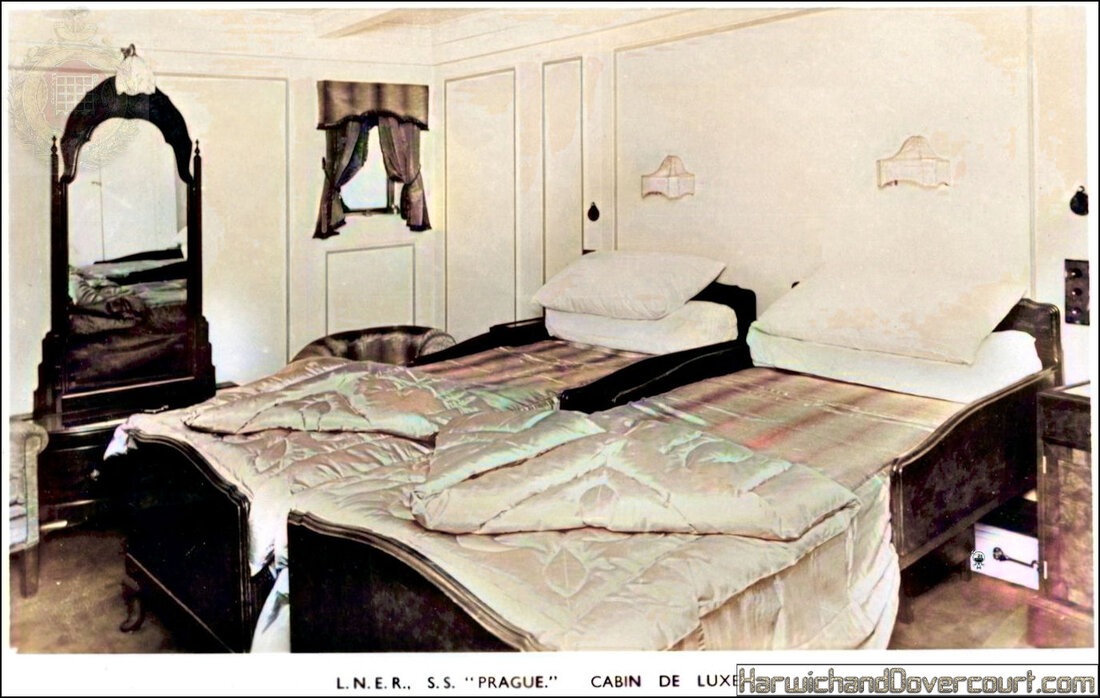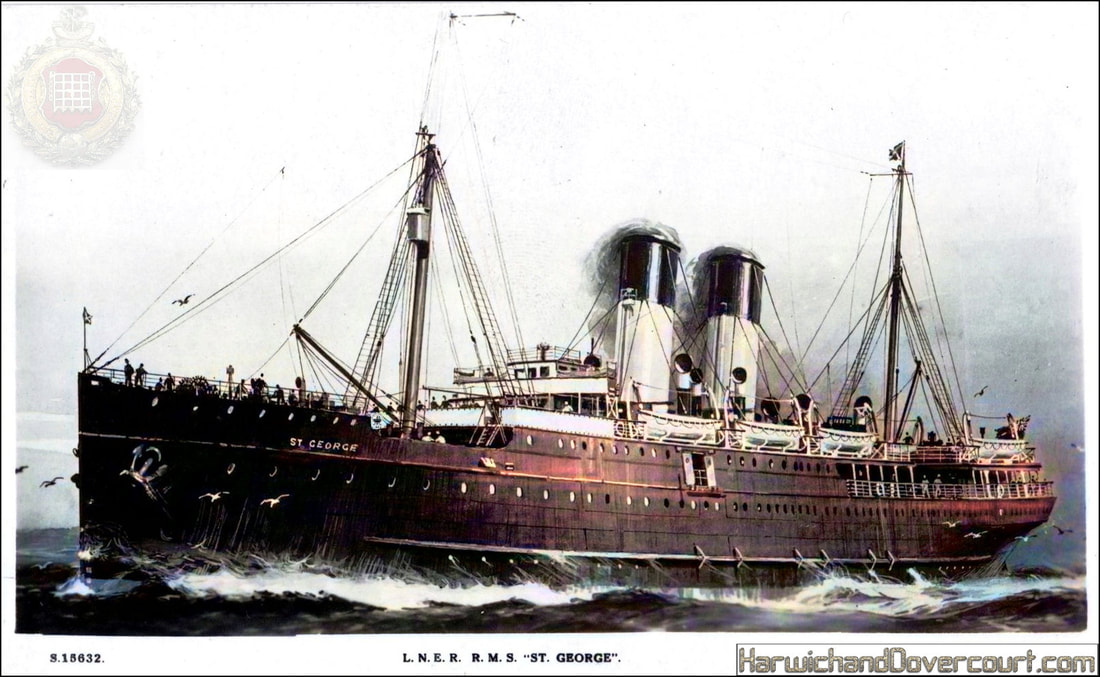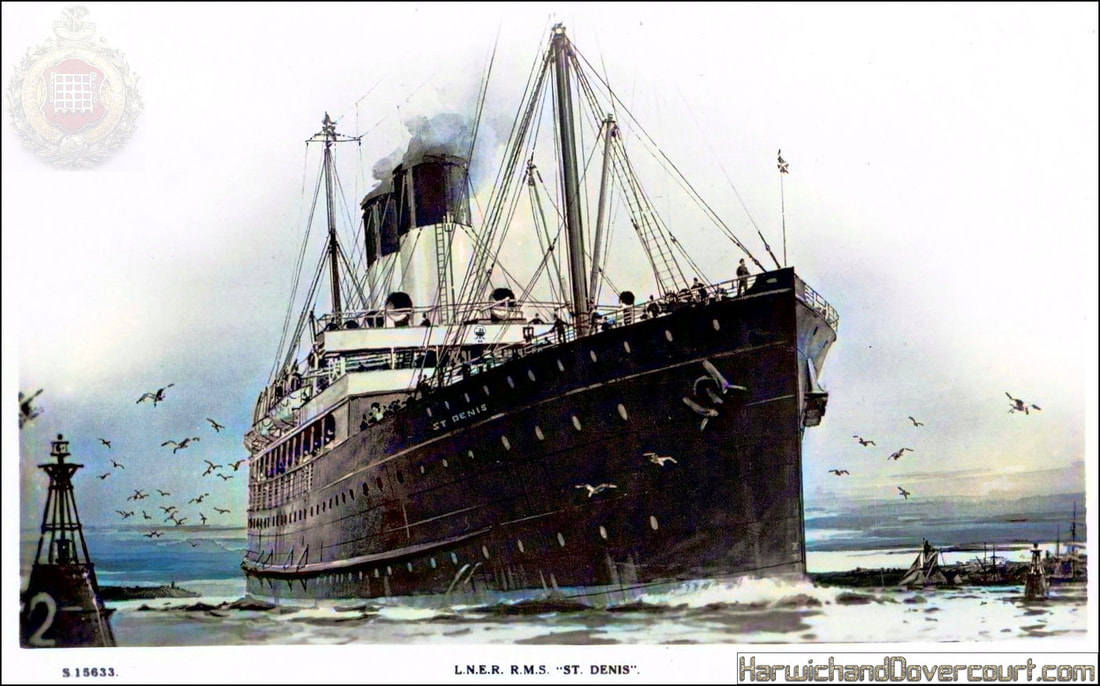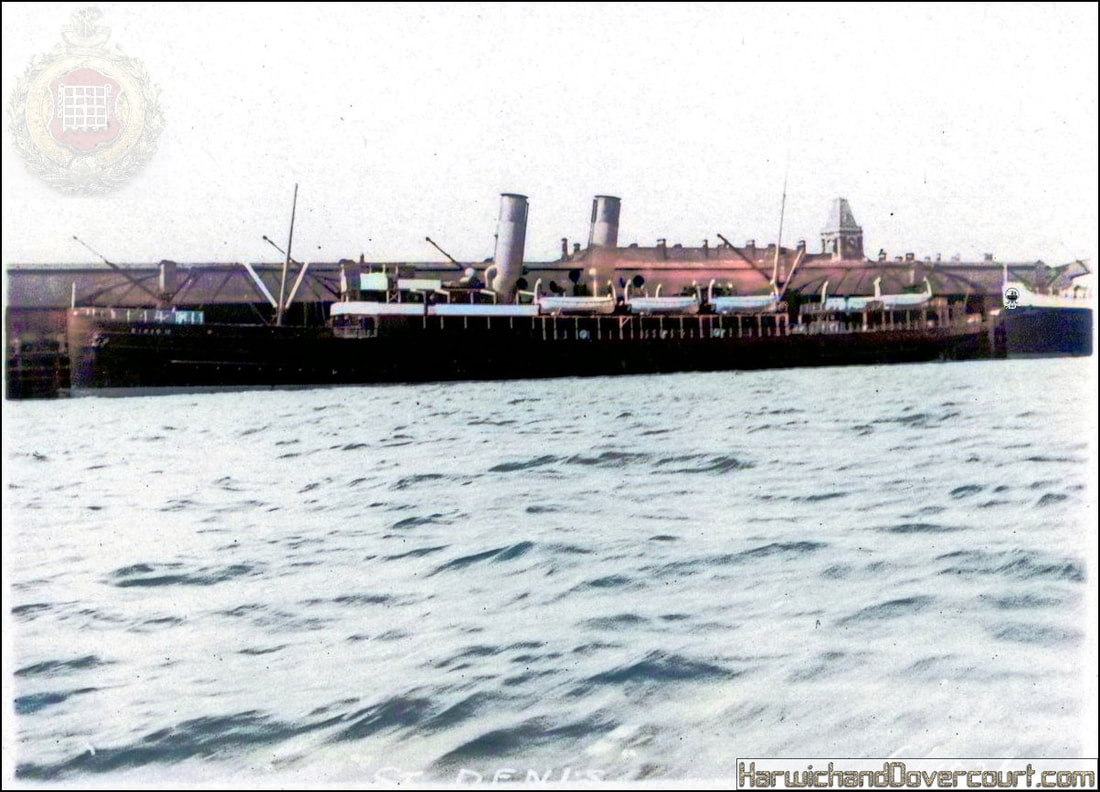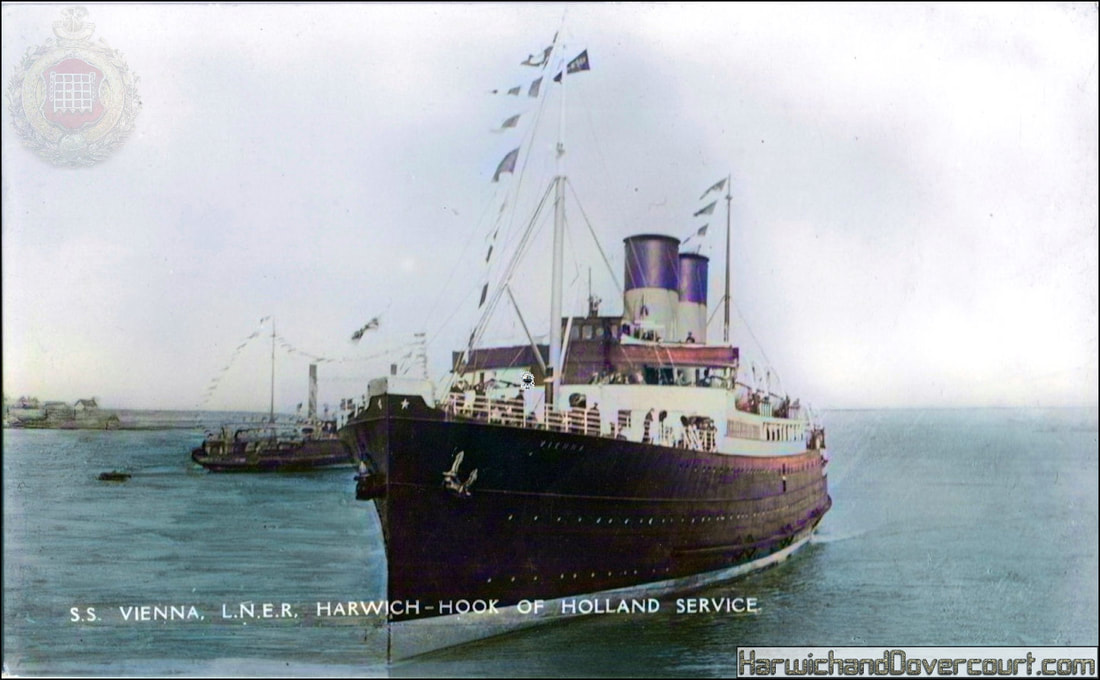A selection of L.N.E.R Steamers operating from the Harwich & Parkeston ports.
~ S.S. Accrington Entering Grimsby Dock H&D (1921) ~
The S.S. Accrington was one of five sister ships built in 1910 for the old Great Central Railway. requisitioned in 1915, Accrington became a P.O.W. accommodation ship, then in 1940 on English Channel services. In 1917-1918 she was a Training Ship based at Portsmouth. Post-war she was briefly chartered for GER’s Rotterdam to Harwich repatriation service before taking up the Grimsby – Hamburg route.
Acquired by LNER in 1923 and passed to Associated Humber Lines in 1934. From July 1942 used as a convoy rescue ship during the Second World War and completed 40 escort voyages.
In January 1951 she made her last sailing on the Harwich-Antwerp service and was sold for breaking at Dunston-on-Tyne where she arrived on 3 May 1951.
Acquired by LNER in 1923 and passed to Associated Humber Lines in 1934. From July 1942 used as a convoy rescue ship during the Second World War and completed 40 escort voyages.
In January 1951 she made her last sailing on the Harwich-Antwerp service and was sold for breaking at Dunston-on-Tyne where she arrived on 3 May 1951.
~ S.S. Accrington Harwich to Antwerp Route H&D ~
~ S.S. Amsterdam (1930) ~
The S.S. Amsterdam was a passenger and freight vessel built for the London and North Eastern Railway in 1930.
History
The ship was built by John Brown on Clydebank. She was one of an order for three ships, the others being Vienna and Prague. She was launched on 30 January 1930.
On 14 October 1932, she brought Prince George, Duke of Kent back from his tour of Denmark, Sweden and the Netherlands.
War Service
In September 1939, at the outbreak of the Second World War, the ship was requisitioned by the Ministry of War Transport for troop transport. This included transporting the 51st Highland Division and Princess Louise's Kensington Regiment from Southampton to Le Havre in April 1940 as part of the British Expeditionary Force.
By 1944, she had been converted to a LSI (H) - Landing Ship Infantry (Hand-hoisting). She carried elements of the United States 2nd Ranger Battalion to Pointe du Hoc on D-day.
By 19 July 1944, she had been converted to a Hospital Carrier ship. On 7 August 1944, she was sunk by a mine while taking casualties from Juno Beach, Calvados, France. A total of 55 patients, ten Royal Army Medical Corps staff, 30 crew and eleven prisoners of war were killed.
Seventy five wounded soldiers were carried up and delivered into lifeboats, but two of the nurses, Dorothy Field, 32, and Mollie Evershed, 27, went back below and went down with the ship. They are the only two women whose names are on the British Normandy Memorial, with 22,000 men.
History
The ship was built by John Brown on Clydebank. She was one of an order for three ships, the others being Vienna and Prague. She was launched on 30 January 1930.
On 14 October 1932, she brought Prince George, Duke of Kent back from his tour of Denmark, Sweden and the Netherlands.
War Service
In September 1939, at the outbreak of the Second World War, the ship was requisitioned by the Ministry of War Transport for troop transport. This included transporting the 51st Highland Division and Princess Louise's Kensington Regiment from Southampton to Le Havre in April 1940 as part of the British Expeditionary Force.
By 1944, she had been converted to a LSI (H) - Landing Ship Infantry (Hand-hoisting). She carried elements of the United States 2nd Ranger Battalion to Pointe du Hoc on D-day.
By 19 July 1944, she had been converted to a Hospital Carrier ship. On 7 August 1944, she was sunk by a mine while taking casualties from Juno Beach, Calvados, France. A total of 55 patients, ten Royal Army Medical Corps staff, 30 crew and eleven prisoners of war were killed.
Seventy five wounded soldiers were carried up and delivered into lifeboats, but two of the nurses, Dorothy Field, 32, and Mollie Evershed, 27, went back below and went down with the ship. They are the only two women whose names are on the British Normandy Memorial, with 22,000 men.
~ S.17920. L.N.E.R. S.S.Amsterdam (1931) Kingsway H&D ~
~ S.S. Amsterdam, at Parkeston Quay, Essex (1938) H&D ~
~ L.N.E.R. R.M.S. Amsterdam First Class Single Berth. 33 H&D ~
~ S.15629 LNER R.M.S. Antwerp (1919) H&D ~
The RMS Antwerp was a passenger vessel built for the Great Eastern Railway in 1919.
History
The ship was built by John Brown of Clydebank for the Great Eastern Railway as one of a contract for two new steamers and launched on 26 October 1919. She was placed on the Harwich to Antwerp route.
In 1923 she was acquired by the London and North Eastern Railway. On 20 November 1932 she collided with the American steamer Hastings in a thick fog off Zeebrugge, but was only lightly damaged, and able to continue her voyage.
She served as a Q-ship in World War I.
She was acquired by British Railways in 1948 and scrapped in 1951.
History
The ship was built by John Brown of Clydebank for the Great Eastern Railway as one of a contract for two new steamers and launched on 26 October 1919. She was placed on the Harwich to Antwerp route.
In 1923 she was acquired by the London and North Eastern Railway. On 20 November 1932 she collided with the American steamer Hastings in a thick fog off Zeebrugge, but was only lightly damaged, and able to continue her voyage.
She served as a Q-ship in World War I.
She was acquired by British Railways in 1948 and scrapped in 1951.
~ R.M.S. Antwerp at Parkeston Quay, Essex (1922) H&D ~
~ S.7826 LNER RMS Archangel (Kingsway Real Photo Series) (1929) H&D ~
SS St Petersburg was a North Sea passenger ferry that was built in Scotland in 1908 for the Great Eastern Railway (GER). In the 1923 railway grouping she passed to the new London and North Eastern Railway (LNER). She was sunk by enemy action in 1941. The Admiralty requisitioned her in both world wars as a troop ship. In 1915 she was renamed S.S. Archangel.
Building
St Petersburg was the third of three sister ships that John Brown & Company of Clydebank, Dumbartonshire built for the GER. She was preceded by Copenhagen, launched in 1907 and Munich, launched in 1908. Brown built St Petersburg as yard number 397. A Miss Green launched her on 25 April 1910. She was the daughter of Frederick Green, a GER director.
St Petersburg's registered length was 330.8 ft (100.8 m), her beam was 43.2 ft (13.2 m) and her depth was 18.8 ft (5.7 m). Her tonnages were 2,448 GRT and 1,039 NRT. She had three steam turbines and three screws. Each turbine drove its respective screw by direct drive. She was equipped with submarine signalling and wireless telegraphy.
Career
The GER registered St Petersburg at Harwich. Her United Kingdom official number was 123940 and her code letters were HRFS. Her regular route was between Harwich and Hook of Holland.
By 1913 St Petersburg's wireless telegraph call sign was PQP. By 1914 it had been changed to GPK.
In 1915 the Admiralty requisitioned St Petersburg as a cross-Channel troop ship, and renamed her Archangel. After the First World War she was returned to the GER, which in 1923 was absorbed by the new LNER.
On 20 January 1925 she ran aground at the Hook of Holland. Three tugs brought her passengers ashore. By 1930 Archangel's call sign was GRNV. By 1934 this had superseded her code letters.
Loss
In the Second World War Archangel was again requisitioned as a troop ship. On 16 May 1941 she embarked 182 and 196 batteries of 65th (The Manchester Regiment) Anti-Aircraft Brigade at Kirkwall to take them to Aberdeen. The destroyer HMS Blankney escorted her.
Just before midnight that night, three German Heinkel He 111 bomber aircraft attacked the two ships in the North Sea at position 57°55′N 2°03′W. One aircraft, flying at an altitude of 50 feet (15 m), dropped two bombs, one of which hit Archangel in her engine room and boiler room, caused a boiler explosion, and severed communication between the fore and aft of the ship. The same aircraft returned at an altitude of 500 feet (150 m) to strafe Archangel, as the other two He 111s engaged Blankney. Both ships returned fire, and Blankney circled Archangel at speed. The He 111 that attacked Archangel made three runs, and was then damaged and crashed into the sea. The other two aircraft then withdrew.
Blankney launched her boats to rescue survivors, and went alongside Archangel to complete the evacuation. Blankney's surgeon came aboard to assist Archangel's medical officer. Blankney reached Aberdeen about 0800 hrs on 17 May. Casualties included 38 killed and 18 wounded in 182 battery; and three killed and 24 wounded in 196 battery; all suffering from burns. Archangel's Master, Captain AP Sutton, was badly wounded. Accounts differ as to the number of casualties in his crew. Also on 17 May, either Blankney or a tug (accounts differ) took Archangel in tow. The troop ship beached at Blackdog, just north of Aberdeen, and broke into four pieces.
Building
St Petersburg was the third of three sister ships that John Brown & Company of Clydebank, Dumbartonshire built for the GER. She was preceded by Copenhagen, launched in 1907 and Munich, launched in 1908. Brown built St Petersburg as yard number 397. A Miss Green launched her on 25 April 1910. She was the daughter of Frederick Green, a GER director.
St Petersburg's registered length was 330.8 ft (100.8 m), her beam was 43.2 ft (13.2 m) and her depth was 18.8 ft (5.7 m). Her tonnages were 2,448 GRT and 1,039 NRT. She had three steam turbines and three screws. Each turbine drove its respective screw by direct drive. She was equipped with submarine signalling and wireless telegraphy.
Career
The GER registered St Petersburg at Harwich. Her United Kingdom official number was 123940 and her code letters were HRFS. Her regular route was between Harwich and Hook of Holland.
By 1913 St Petersburg's wireless telegraph call sign was PQP. By 1914 it had been changed to GPK.
In 1915 the Admiralty requisitioned St Petersburg as a cross-Channel troop ship, and renamed her Archangel. After the First World War she was returned to the GER, which in 1923 was absorbed by the new LNER.
On 20 January 1925 she ran aground at the Hook of Holland. Three tugs brought her passengers ashore. By 1930 Archangel's call sign was GRNV. By 1934 this had superseded her code letters.
Loss
In the Second World War Archangel was again requisitioned as a troop ship. On 16 May 1941 she embarked 182 and 196 batteries of 65th (The Manchester Regiment) Anti-Aircraft Brigade at Kirkwall to take them to Aberdeen. The destroyer HMS Blankney escorted her.
Just before midnight that night, three German Heinkel He 111 bomber aircraft attacked the two ships in the North Sea at position 57°55′N 2°03′W. One aircraft, flying at an altitude of 50 feet (15 m), dropped two bombs, one of which hit Archangel in her engine room and boiler room, caused a boiler explosion, and severed communication between the fore and aft of the ship. The same aircraft returned at an altitude of 500 feet (150 m) to strafe Archangel, as the other two He 111s engaged Blankney. Both ships returned fire, and Blankney circled Archangel at speed. The He 111 that attacked Archangel made three runs, and was then damaged and crashed into the sea. The other two aircraft then withdrew.
Blankney launched her boats to rescue survivors, and went alongside Archangel to complete the evacuation. Blankney's surgeon came aboard to assist Archangel's medical officer. Blankney reached Aberdeen about 0800 hrs on 17 May. Casualties included 38 killed and 18 wounded in 182 battery; and three killed and 24 wounded in 196 battery; all suffering from burns. Archangel's Master, Captain AP Sutton, was badly wounded. Accounts differ as to the number of casualties in his crew. Also on 17 May, either Blankney or a tug (accounts differ) took Archangel in tow. The troop ship beached at Blackdog, just north of Aberdeen, and broke into four pieces.
~ S.S. Archangel with Padre Bloxham and some "Pilgrims" H&D ~
~ The Continent via Harwich G.E.R. Archangel ~ Reservation Telegram (1920) H&D ~
~ S.S. Arnhem (1948) at Parkeston Quay, Essex H&D ~
The S.S.Arnhem was a passenger and cargo vessel built for the London and North Eastern Railway in 1946.
History
The ship was built by John Brown on Clydebank and launched on 7 November 1946. She was the first in a series of ships to replace war losses, and was the first oil-fired ship ordered by the company. She had capacity for 600 passengers, and 50,000 cubic feet (1,400 m3) of grain.
In March 1953 she rescued 29 men from the Swedish ship Rigel (3,823 tons) which sank after a collision with an Italian vessel Senegal (1,650 tons) some 60 miles from Ostend.
Initially she was a single class vessel but was converted for first and second classes in 1954. She was taken over by the British Railways in 1948. She was scrapped in 1968 by Thos. W. Ward at Inverkeithing.
History
The ship was built by John Brown on Clydebank and launched on 7 November 1946. She was the first in a series of ships to replace war losses, and was the first oil-fired ship ordered by the company. She had capacity for 600 passengers, and 50,000 cubic feet (1,400 m3) of grain.
In March 1953 she rescued 29 men from the Swedish ship Rigel (3,823 tons) which sank after a collision with an Italian vessel Senegal (1,650 tons) some 60 miles from Ostend.
Initially she was a single class vessel but was converted for first and second classes in 1954. She was taken over by the British Railways in 1948. She was scrapped in 1968 by Thos. W. Ward at Inverkeithing.
~ LNER S.S. Arnhem ~ Lounge (1948) H&D ~
~ British Railways S.S. Arnhem (1950) H&D ~
~ S.20366 ~ British Railways S.S. Arnhem (1952) H&D ~
~ S.S. Arnhem Harwich Boot at the Hook of Holland (1954) H&D ~
~ The S.S. Duke Of York British Railways (1952) H&D ~
Built in 1963 by Alexander Stephen & Sons, Glasgow. Served until 1980 when sold to Seafaith Navigation Co, Limassol, Cyprus and renamed Valon. Scrapped at Gadani Beach, Pakistan in January 1981
13 37 LNER R.M.S. Maline (1928) H&D FW
The R.M.S. Malines was a passenger vessel built for the Great Eastern Railway in 1921
History
The ship was built by Armstrong Whitworth and Company in High Walker and launched on 6 January 1921 by Mrs. John Kenneth Foster. She was a sister ship for the Antwerp and Bruges which were introduced on the Harwich to Antwerp service in 1920. She made her maiden voyage to Antwerp on 21 March 1922. The Great Eastern Railway was taken over by the London and North Eastern Railway company in 1923.
In 1932 she was in collision with the tanker Hanseat, and was run on to a sandbank in the River Scheldt. She was refloated by six tugs and towed up the river to be docked in Antwerp. On 7 May 1933 she was in collision in the fairway off Flushing with the Swedish steamer Jamaica (945 tons), and the collision resulted in the sinking of the Jamaica. In 1936 she was in collision with the Dutch vessel Almkirk (6,810 tons), but there were no casualties.
In 1940 she was requisitioned by the Royal Navy and renamed HMS Malines. She was used as an auxiliary Convoy Escort Vessel. On 19 July 1942 she was torpedoed by German aircraft and beached near Port Said, Egypt. She was re-floated in January 1943 and used as a training hulk through the end of the War. In June 1945 she was towed by Empire tug Susan from Port Said to Falmouth, but the journey was delayed when the hold filled with water between Gibraltar and Lisbon. She eventually returned to the Tyne on 8 November 1945.
History
The ship was built by Armstrong Whitworth and Company in High Walker and launched on 6 January 1921 by Mrs. John Kenneth Foster. She was a sister ship for the Antwerp and Bruges which were introduced on the Harwich to Antwerp service in 1920. She made her maiden voyage to Antwerp on 21 March 1922. The Great Eastern Railway was taken over by the London and North Eastern Railway company in 1923.
In 1932 she was in collision with the tanker Hanseat, and was run on to a sandbank in the River Scheldt. She was refloated by six tugs and towed up the river to be docked in Antwerp. On 7 May 1933 she was in collision in the fairway off Flushing with the Swedish steamer Jamaica (945 tons), and the collision resulted in the sinking of the Jamaica. In 1936 she was in collision with the Dutch vessel Almkirk (6,810 tons), but there were no casualties.
In 1940 she was requisitioned by the Royal Navy and renamed HMS Malines. She was used as an auxiliary Convoy Escort Vessel. On 19 July 1942 she was torpedoed by German aircraft and beached near Port Said, Egypt. She was re-floated in January 1943 and used as a training hulk through the end of the War. In June 1945 she was towed by Empire tug Susan from Port Said to Falmouth, but the journey was delayed when the hold filled with water between Gibraltar and Lisbon. She eventually returned to the Tyne on 8 November 1945.
~ LNER R.M.S. Malines Harwich-Antwerp Service (1923) H&D ~
~ L.N.E.R. The S.S. Prague (1930) by Kingsway H&D ~
The S.S. Prague was a passenger and freight vessel built for the London and North Eastern Railway in 1929. The first group of Kindertransport refugees to arrive in the UK did so aboard the Prague, in December 1938.
History
The ship was built by John Brown on Clydebank. She was one of an order for three ships, the others being Vienna and Amsterdam. She was launched on 18 November 1929. She arrived in Harwich Parkeston Quay on 22 February 1930.
In June 1932 she collided with a Belgian fishing smack in dense fog which resulted in the fishing boat sinking in less than 2 minutes, and four of the five crew were drowned.
Memorial plaque at Harwich
She brought the first group of unaccompanied child refugees to Britain from Nazi Germany, arriving at Parkeston Quay on 2 December 1938. A plaque unveiled in 2011 at Harwich harbour marks this event.
At the outbreak of the Second World War the ship was requisitioned by the Ministry of War Transport. The Prague was one of seven Harwich ships which took part in the 1940 evacuations from Dunkirk. She made three trips between May 28 and June 1st, 1940. It was during her third trip that she was dive-bombed. Captain Baxter, the master, avoided a direct hit by evasive action. One of her engines was put out of action and she rapidly filled with water aft. Almost three thousand French troops were taken off by other vessels in mid Channel whilst still maintaining her best speed The Prague was eventually beached near Deal, Kent. The ship's chief engineer, Walter Ernest Oxenham was awarded the DSC for his part in the action. In 1944, Prague served in the D-Day landings. SS Prague made more than 50 return journeys as a hospital ship after D-Day
She was sent to Clydebank for refurbishing in 1947 but was severely damaged by fire, and sent for scrapping in September 1948.
History
The ship was built by John Brown on Clydebank. She was one of an order for three ships, the others being Vienna and Amsterdam. She was launched on 18 November 1929. She arrived in Harwich Parkeston Quay on 22 February 1930.
In June 1932 she collided with a Belgian fishing smack in dense fog which resulted in the fishing boat sinking in less than 2 minutes, and four of the five crew were drowned.
Memorial plaque at Harwich
She brought the first group of unaccompanied child refugees to Britain from Nazi Germany, arriving at Parkeston Quay on 2 December 1938. A plaque unveiled in 2011 at Harwich harbour marks this event.
At the outbreak of the Second World War the ship was requisitioned by the Ministry of War Transport. The Prague was one of seven Harwich ships which took part in the 1940 evacuations from Dunkirk. She made three trips between May 28 and June 1st, 1940. It was during her third trip that she was dive-bombed. Captain Baxter, the master, avoided a direct hit by evasive action. One of her engines was put out of action and she rapidly filled with water aft. Almost three thousand French troops were taken off by other vessels in mid Channel whilst still maintaining her best speed The Prague was eventually beached near Deal, Kent. The ship's chief engineer, Walter Ernest Oxenham was awarded the DSC for his part in the action. In 1944, Prague served in the D-Day landings. SS Prague made more than 50 return journeys as a hospital ship after D-Day
She was sent to Clydebank for refurbishing in 1947 but was severely damaged by fire, and sent for scrapping in September 1948.
~ L.N.E.R. The S.S.Prague (1934) H&D ~
~L.N.E.R. The S.S. Prague Corner of First Class Smoking Room (1930) H&D ~
~ L.N.E.R. The S.S. Prague First Class Entrance On Promenade Deck. (1930) H&D ~
~ L.N.E.R. The S.S. Prague Cabin De Luxe. (1930) H&D ~
~ L.N.E.R. The S.S. Prague First Class Single Berth. (1930) H&D ~
~ S.15632. The L.N.E.R. R.M.S. St George (1928) H&D ~
Built for the Fishguard & Rosslare Railways & Harbours Board for their Irish Sea service. Sold in 1913 to the Canadian Pacific Railway Company, London for service in the Bay of Fundy. Returned to the U.K. in 1915 as a hospital carrier until 1918.
Purchased by the GER in 1919.
Broken up at Blyth Q4/1929
Purchased by the GER in 1919.
Broken up at Blyth Q4/1929
~ S.15633. L.N.E.R. The R.M.S. St Denis (1928) H&D ~
Built by John Brown and Company at Clydebank in 1908 as "Munich" for the Great Eastern Railway for service on the Harwich – Hook of Holland route. Requisitioned in the First World War for use as a hospital ship and renamed St Denis.
Acquired by L.N.E.R. in 1923 and continued to serve the Hook of Holland route until 1932 when she was relegated to summer secondary services by new buildings on the Hook route.
She was employed in evacuation duties at Amsterdam in 1940 when she became trapped and was scuttled. Salvaged by the Germans and served until scrapped in 1950, having been renamed twice as Skorpion and Barbara in the interim.
Acquired by L.N.E.R. in 1923 and continued to serve the Hook of Holland route until 1932 when she was relegated to summer secondary services by new buildings on the Hook route.
She was employed in evacuation duties at Amsterdam in 1940 when she became trapped and was scuttled. Salvaged by the Germans and served until scrapped in 1950, having been renamed twice as Skorpion and Barbara in the interim.
~ The R.M.S. St Denis at Parkeston Quay, Essex (1926) H&D ~
~ S.S. Vienna L.N.E.R. Harwich-Hook of Holland Service (1938) H&D FW
The S.S. Vienna (Both ships) have there own special page, just click on the image above to locate it
